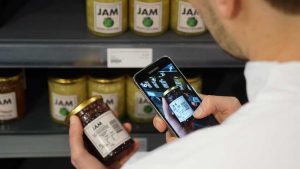7-Eleven Inc. is among the latest retailers to empower consumers to become their own point-of-sale checkout when they use an app on their smart phones.
A central component of that capability is the image-capture tool built into the app. The 7-Eleven Scan & Pay service, which is in tests now and is expected to have greater availability in 2019, relies on Scandit AG image-capture technology to accurately scan a product bar code.

The Scandit algorithm first determines there is an object in the smart phone’s camera view, then it identifies the barcode, Samuel Mueller, chief executive and cofounder, tells Digital Transactions News. The barcode is decoded and converted into a universal product code. That information is sent to the merchant’s backend system for identification and pricing information, which is then rendered on the device, he says. The process happens in milliseconds.
Scandit’s role in payment is its ability to capture the product information via an image. Zurich-based Scandit does not provide the actual transaction function. Instead, most clients use existing payments partners, Mueller says.
The technology will only become more vital as more retailers adopt similar self-checkout services, Mueller says. “If you think about some of the big trends and visible projects in the market, one of the things that comes to mind is AmazonGo,” Mueller says. Amazon.com Inc.’s AmazonGo convenience stores use sensors and cameras to determine which items a shopper picks up and leaves the store with. The payment is made using the consumer’s Amazon payment credentials.
While AmazonGo is limited to a handful of store locations and to consumers with Amazon accounts, and also carries a high cost to duplicate, apps that focus on the consumer stand a better chance for retailer adoption, Mueller says. The trend to enable consumers to check out on their own phones has much broader appeal, he says. That also means self-checkout is available to more store types, too.
“What’s generally the case across these solutions is the shopping happens at the consumer’s own pace,” Mueller says. It also is much more personal, given the consumer may have started the shopping process with a map search or product search prior to visiting the store.
Some retailers may even adopt augmented-reality shopping, he suggests. In this scenario, once a shopper activates a retailer app and points the phone’s camera at products in a store, she could see pricing and product information and filter for size and other attributes. This will result in technology that can seamlessly blend the physical and digital shopping realms, Mueller says.
Others are trying to combine the two shopping environments. Earlier this week, Mastercard Inc. said it was working with Next Retail Concepts on a 3-D shoppable online experience.







